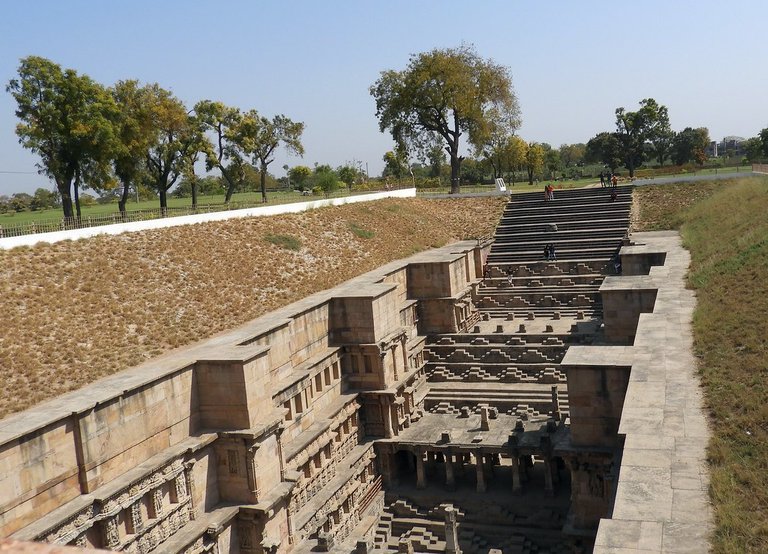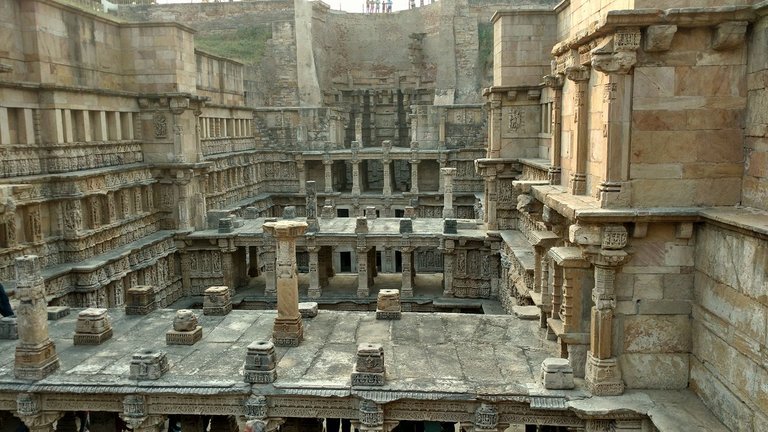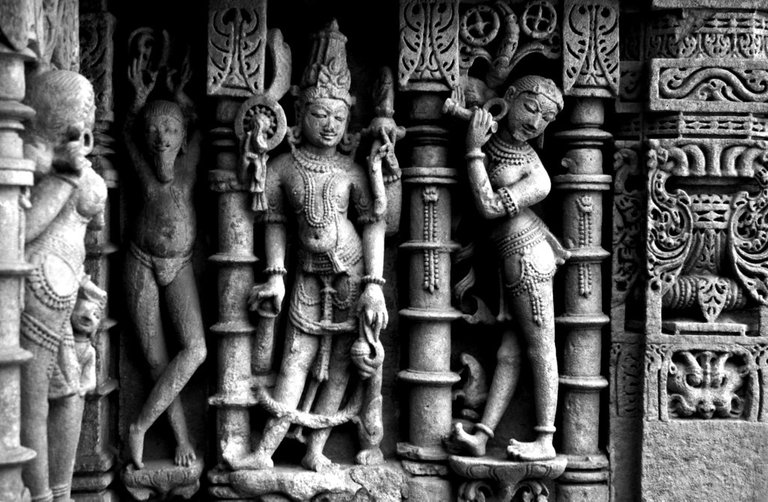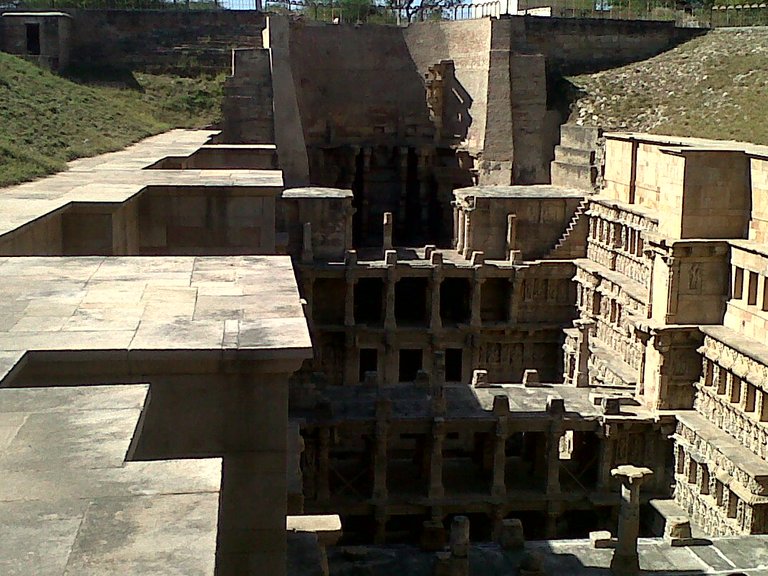This very famous architectural heritage of India is located on the banks of the Saraswati River in Patan district of Gujarat.
The fact that it was made a UNESCO World Heritage Site in 2014 and in 2016 was also awarded for being the cleanest heritage site in the country. This should be reason enough for you to explore this amazing piece of architecture from the Solanki dynasty.
And if this is not enough, you will be fascinated to know that 'Rani ki Vav' or the queen has been made in memory of her husband; Unlike many others, which are made by the emperors for their beloved queen.
Ran Ki Vav, or Rani Ki Bawdi, is located in Patan city of Gujarat. It is a stunning example of the Royal Step Well and was constructed between 1022 and 1063 AD.

Source
This beautiful building was rediscovered in the 1980s, after several years of being lost in the forests in the 1950s.
The intense carving here is wonderfully preserved. The place contains many unique features that have made it one of the most important stepwells in the country.
Like most small towns in India, Patan is a strange kind of mix and is shiny, old and new.
In the old city, where Ran Ki Vav is, once ancient parts of a fort can still be seen. Locals believe that the fort was built in one night by Babur Bhoot, on the orders of a ruler of Patan.
There are also ruins of an old mansion, and huge doors or gates, which once served as the entrance and exit point for entering the city.
The city owes its origin to the Chavada dynasty that rules here. Patan was once the capital of Gujarat. Patan was founded in the 8th century by the Chavada ruler Vanraj.

Source
During the 10th – 13th centuries, the city was the capital of the Chalukyas, who overthrew the Chavadas. It is estimated that Anhilwara was the tenth largest city in the world in the year 1000 with a population of about 1000.
An information box in the Town Museum states that "during these years (942–1244 AD), the city was a great place of learning and a prosperous trading center. The rulers were great patrons of fine arts and architecture and worked to build many civic and religious areas in the city.
Muhammad's general and later Delhi's Sultan Qutb-ud-din Ayybak sacked the city between 1200 and 1210, and it was destroyed in 1298 by Alauddin Khilji.
The modern city of Patan later settled near the ruins of Anilwara. During 1304 to 1411, the first Patan was the Diocese headquarters of the Delhi Sultanate and the capital of the Gujarat Sultanate after the fall of the Delhi Sultanate at the end of the 14th century.
A new fort was built by these diocese, a large part of which (with some gates) still remains. The old fort of the Hindu state has almost disappeared and only one wall can be seen on the way from Kalka to Rani ki vav. In 1411, Sultan Ahmed Shah moved the capital to Ahmedabad.
Patan was a part of the Baroda state from the mid-18th century until India's independence from 1947, when Baroda became part of the Bombay state, which was separated into Gujarat and Maharashtra in 1960.
Vanararaj Singh's bravery is reflected in the fact that he built the state capital on the land of north Gujarat. There is no hill top nor any huge fort. It was said that during his tenure there was no one with equal power in Western and Northern India.
The grand structure is believed to have been built by the widow Queen Udayamati in memory of her beloved husband Bhimdev I (1022 to 1063 AD), the son of Mulraj, the founder of the Solanki dynasty of Anhilwara Pattan.
Usually kings make such memorials for their queens after their death. But here it is the opposite. Although popular history had always given credit to Udayamati for creating this Vav, historical research has also established her relationship with this Vav.
Construction of the Rani Ni Vav began around 1050 AD and was probably completed by Udayamati and Karandeva I. 1304 AD I can find reference to Udayamati who built the memorial in 'Prabandha Chintamani' composed by Merunga Suri.
The idols here represent a religious, mythological and secular image. The central theme of the idols are about 10 incarnations of Vishnu. At the water level, there is a statue of Vishnu on a snake with 1,000 heads. Other sculptures represent the Apsaras (heavenly Apsaras), who are very beautiful in specialty and posture.
Like other stepwells, the Rani Ni Vav was not used only to collect water; It held great spiritual significance and was also a place for socialization.
It was built on the banks of river Saraswati. Years later, as the Saraswati River changed its course, its floods largely filled its structure and it was buried.
Clean Debris
It was later excavated by the Archaeological Survey of India in the late 1980s. It was restored to its original design and is now in very good condition.
The Archaeological Survey of India carried out evacuation and restoration work for Vav, which was filled with mud and water. As the process of desilting and debris extraction began, the water also began to recede. The sludge was cleaned slightly by hand and carefully examined the antiquities that could be mixed with the sludge before disposal.
It was a very risky project. Work was slow - this process took more than three decades to complete.
During the excavation, a marble statue was found inside the Vav, which was that of Queen Udayamati.
Architecture of the Rani ka Vav
Rani Ka Vav has been cited as one of the finest specimens of architecture, reflecting the typical Maru-Gurjar architectural style.
The first thing that you see about Rani ki Vav is its size! It is huge, the largest stepwell of its kind, and is very beautiful.
But it is all down to the ground. From the field, it arises suddenly as you come near.
It is built as an inverted temple with four pavilions at various levels, highlighting the purity of water.

Source
As you descend seven levels, you can see the sculpture with the highest artistic quality, including 500 major sculptures and 1,000 smaller ones.
The entire structure is made of sandstone. The adjacent corridors around the pillared pavilions or roofs go under the reservoir (or tank). The well is beyond that. Both the walls of the vavas and the corridors are adorned with sculptures.
The well is separated on the seventh level in a staircase adorned with sculptural panels of high artistic quality with more than five hundred major sculptures and more than a thousand other religious and mythological figures, often referring to literary works.
The fourth level, oriented in an east-west direction, leads to a rectangular tank (9.5 m to 9.4 m) at a depth of 23 m.
This well also holds religious significance and is thus built as an inverted temple highlighting the purity of water.
Many types of stone structures are depicted here which depict various forms of Lord Vishnu like Kalki, Rama, Krishna, Narasimha, Vamana, Varaha. Interestingly, sculptures of various yoginis and apsaras can be seen here depicting sixteen styles of 'sixteen-adornment' or own ornamentation.
The site is a fine specimen of the elaborate Solanki structural design. It is 64 meters in length and 20 meters in width. When the Rani ki Vav was originally built, it had seven floors. Of them, only five are currently preserved. The depth of this charming stepwell is 27 meters and it is oriented towards east-west direction. It has a long corridor leading down to the underground tank.
Importance of Rani's Vav
The Vavas of Gujarat were of great spiritual importance in the past, besides the site of water gathering and socialization. Although initially, the design of these wells tended more toward a simplified design, these styles became more complex and artistic over time. This was done primarily to emphasize the purity of the water stored in the vavas. Rani ka Vav is one such example which gives a feeling of an underground temple upon entering.
Here the idols and statues of Lord Vishnu are most beautified. The common theme of Rani Ki Vav is ‘Dasavatara’ or the ten incarnations of the deity. The well descends on seven levels below the ground where you can observe 800 different statues spread over seven corridors.
They are incarnations of Lord Vishnu, namely, Matsya, Kurma, Varaha, Narasimha, Vamana, Parasurama, Rama, Krishna, Buddha, and Kalki with idols of sages, Brahmins and celestial dancers or 'Apsaras'. The most attractive idol here is situated on the water level of Rani's Vav, depicting Lord Vishnu resting on a thousand-faced snake.
UNESCO has also recognized this outstanding artwork as an exceptional example of technological development in the use of groundwater resources and water management systems.
It is not only an underground water storage system, but also an architectural wonder. Rani Ki Vav is a testimony to the quality of workmanship that has been fighting natural disasters and wars over time.

Source
Until 2001, visitors were allowed to walk to the end of the ladder. But after the Bhuj earthquake, the stability of various parts was put at risk. Today, some parts are closed to the public.
Reportedly, there is also a gate below the last stage of the well, which leads to a 30-meter tunnel and opens in the town of Sidhpur, close to Patan. It was used as an escape gateway during war or invasion.
Finally
A masterpiece of architecture, construction and adornment, Rani ki Vav in Patan, Gujarat, is the only stepwell stepway declared a UNESCO World Heritage Site. It is considered to be the greatest example of this type of complex architectural technique, demonstrating great beauty in proportion and detail.
The prominence of this 900 year old heritage site must be truly appreciated for its beauty and grandeur.
Thanks for being with me, Have a nice day.




I had never heard of this place before, and have a new addition to my "bucket list". This is fantastic! I wish I could like it twice...thanks for sharing!
Unfortunately this place has not got so recognized, even having amazingly rich architecture. I appreciate your feedback.
Hello @orion7, thank you for sharing this creative work! We just stopped by to say that you've been upvoted by the @creativecrypto magazine. The Creative Crypto is all about art on the blockchain and learning from creatives like you. Looking forward to crossing paths again soon. Steem on!
This post earned a total payout of 0.532$ and 0.400$ worth of author reward which was liquified using @likwid. To learn more.